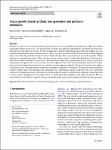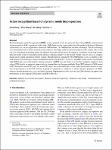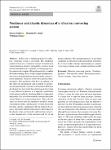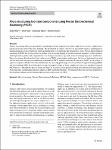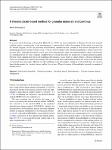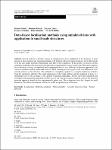Search
Author
- Amir, Ebrahimi (2)
- Aydin, Azizi (2)
- George, Haller (2)
- James, M. Fiore (2)
- next >
Subject
- Engineering (4)
- công nghệ (3)
- kỹ thuật (3)
- Robotics (3)
- next >
Date issued
Search Results
Type B aortic dissection (TBAD) carries a high risk of complications, particularly with a partially thrombosed or patent false lumen (FL). Therefore, uncovering the risk factors leading to FL thrombosis is crucial to identify high-risk patients. Although studies have shown that morphological parameters of the dissected aorta are related to FL thrombosis, often conflicting results have been reported. We show that recent models of thrombus evolution in combination with sensitivity analysis methods can provide valuable insights into how combinations of morphological parameters affect the prospect of FL thrombosis. Based on clinical data, an idealized geometry of a TBAD is generated and parameterized. After implementing the thrombus model in computational fluid dynamics simulations, a g... |
Biological tissues receive oxygen and nutrients from blood vessels by developing an indispensable supply and demand relationship with the blood vessels. We implemented a synthetic tree generation algorithm by considering the interactions between the tissues and blood vessels. We first segment major arteries using medical image data and synthetic trees are generated originating from these segmented arteries. They grow into extensive networks of small vessels to fill the supplied tissues and satisfy the metabolic demand of them. Further, the algorithm is optimized to be executed in parallel without affecting the generated tree volumes. The generated vascular trees are used to simulate blood perfusion in the tissues by performing multiscale blood flow simulations. One-dimensional blood... |
Based on dynamic mode decomposition (DMD), a new empirical feature for quasi-few-shot setting (QFSS) skeleton-based action recognition (SAR) is proposed in this study. DMD linearizes the system and extracts the modes in the form of flattened system matrix or stacked eigenvalues, named the DMD feature. The DMD feature has three advantages. The first advantage is its translational and rotational invariance with respect to the change in the localization and pose of the camera. The second one is its clear physical meaning, that is, if a skeleton trajectory was treated as the output of a nonlinear closed-loop system, then the modes of the system represent the intrinsic dynamic property of the motion. Finally, the last one is its compact length and its simple calculation without training.... |
In this work, a simulation model of a vibratory conveying system is presented. The simulation model is based on a continuous contact formulation in vertical direction which is extended by a friction force in horizontal direction to simulate a conveying process. In contrast with complex 3D simulation tools, it enables the understanding of previously unexplained phenomena such as multiple feeding velocities at the same excitation amplitude, which are observed in practical measurements. The parameters that have an influence on this effect are investigated, and a method for predicting and adjusting the occurrence of multiple solutions is developed. It is shown that the calibration of the system is very difficult in practice, as it depends significantly on the initial conditions which ar... |
In recent years, the impressive growth of new wireless technologies, together with the appearance of new requirements in applications and services, is progressively changing the use of networks. Due to the high mobility required, the network must adapt to the infrastructure to meet the demands of the users. As a result, service providers currently have to over-provision network capacity, which is costly. In addition, considering efficient resource planning in advance involves a lot of labor-intensive efforts. Consequently, network usage analysis is a very useful tool that allows network administrators to find patterns and anomalies. Whilst pattern detection provides administrators the ability to define the infrastructure, anomaly detection provides rich and valuable information for ... |
Surface structuring offers great potential for modifying frictional properties for various applications, such as complex forming processes like sheet-bulk metal forming. The production of surface structures in micrometre range is challenging for manufacturing processes in particular when machining hard-to-cut materials like hardened tool steels. Precise electrochemical machining (PECM) has great potential for surface structuring and shaping of metallic materials regardless of their hardness with high surface quality and comparatively very short process times, especially when structuring large areas and batches. Micro structuring of hardened tool steel surfaces using PECM is investigated in this paper. Surfaces of high-speed tool steel and hot-work tool steel are structured using a c... |
The present paper is devoted to the issue of the Green function matrices that belongs to some three-point boundary- and eigenvalue problems. A detailed definition is given for the Green function matrices provided that the considered boundary value problems are governed by a class of ordinary differential equation systems associated with homogeneous boundary and continuity conditions. The definition is a constructive one, i.e., it provides the means needed for calculating the Green function matrices. The fundamental properties of the Green function matrices—existence, symmetry properties, etc.—are also clarified. Making use of these Green functions, a class of three-point eigenvalue problems can be reduced to eigenvalue problems governed by homogeneous Fredholm integral equation syst... |
In a recent article (Frenning in Comp Part Mech 24:1–4, 2021), we demonstrated that a Delaunay-based strain estimate could be used as a starting point for the development of a particle-based method for continua. In this article, we argue that the Voronoi diagram, dual to the previously used Delaunay tetrahedralization, provides a more natural description of the underlying particulate system. For this reason, a Voronoi-based estimate of the deformation gradient is derived and used to the same effect. Although the gradient vectors cease to be antisymmetric, sums over nearest neighbors vanish, which results in a formulation that not only is linearly complete but also satisfies the patch test irrespective of initial particle placement. Pairwise forces, inferred from the local (nonaffine... |
Virgin olive oil processing results in a large amount of biomass (leaves, pomace, stones and wastewater) during harvesting, pruning and production. In recent years, these by-products have been studied as possible sources of bioactive compounds, and several techniques have been developed, including microwave, ultrasound, subcritical extraction, high hydrostatic pressure, a pulsed electric field, and high-voltage electrical discharge. However, these techniques can be expensive, and may require specialized staff to implement them. Therefore, this study proposes a novel method. Hydrodistillation is a simple and fast technique that can recover valuable compounds from olive oil biomasses. As it uses water as a solvent, it is sustainable, does not harm the environment, and is compatible wi... |
Several methods to localise sources of vibrations have been established in the literature. A great amount of those methods are based on databases with features of known impact positions. Great effort needs to be put into highly expensive experiments that deliver those databases. In this paper, we propose several simulation techniques that may replace the expensive experiments for source localisation. The paper compares the localisation accuracy of simulated and experimental data for two different localisation approaches, the reference database method and neural networks. Both methods process signal arrival time differences from several positions on the structure. The methods are exemplarily applied to a complex small-scale structure from the automotive industry: |


